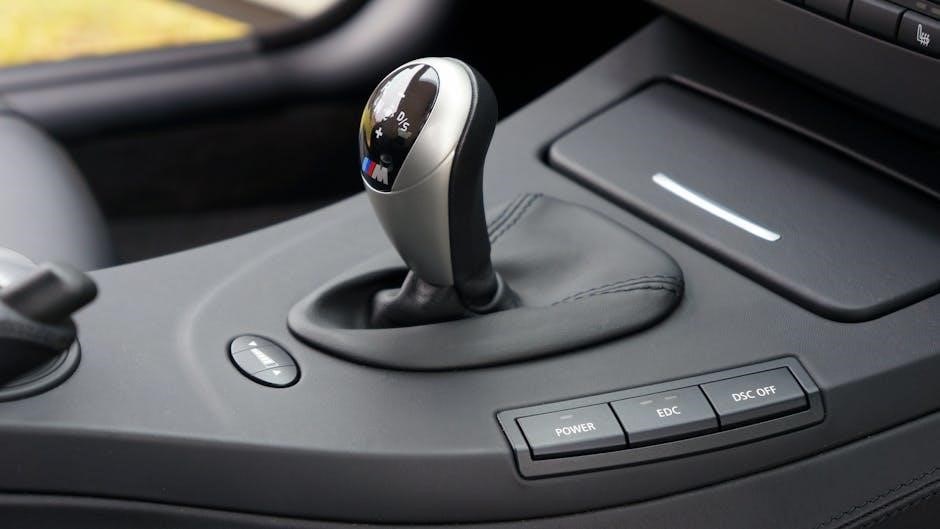e46 m3 manual swap
Welcome to the ultimate guide on converting your BMW E46 M3 from SMG to a manual transmission. This swap enhances reliability, reduces costs, and delivers a more engaging driving experience, making it a popular choice for enthusiasts seeking improved performance and control.
Why Consider an E46 M3 Manual Swap?
Many E46 M3 owners consider swapping from the problematic SMG transmission to a manual gearbox due to reliability concerns and high repair costs. The SMG, while innovative, is prone to issues like hydraulic pump failure, which can be costly to fix. A manual swap offers improved reliability, lower maintenance expenses, and a more engaging driving experience. Enthusiasts often prefer the tactile feel and control of a manual transmission, especially for track use or spirited driving. Additionally, a manual setup can handle higher power outputs, making it a practical choice for modified vehicles. This swap also appeals to those seeking a more traditional driving experience, aligning with the car’s performance-oriented nature.
Overview of the E46 M3 and Its Transmission Options
The BMW E46 M3, introduced in 2000, is renowned for its high-performance capabilities and handling. It was available with two primary transmission options: a 6-speed manual and the SMG (Sequential Manual Gearbox). The SMG, launched in 2001, offered paddle-shifted, automated manual shifting but faced criticism for its reliability and higher maintenance costs. The 6-speed manual, on the other hand, provided a more traditional and engaging driving experience. Both transmissions were designed to complement the M3’s S54 inline-6 engine, but the SMG’s issues led many owners to consider swapping to the more reliable manual setup. This overview highlights the key differences and considerations between these transmission options.

Understanding the SMG Transmission
The SMG (Sequential Manual Gearbox) is an automated manual transmission designed for performance, offering paddle-shifted gear changes without a clutch pedal. Introduced in the E46 M3, it aimed to enhance track performance but faced reliability concerns. Two generations, SMG I and SMG II, were developed, with improvements in later models. Despite its innovative design, the SMG’s complexity and maintenance needs led many enthusiasts to opt for manual swaps.
What is SMG and Its History in the E46 M3?
The SMG (Sequential Manual Gearbox) is an automated manual transmission introduced in the E46 M3 in 2000 as an optional performance-oriented gearbox. Designed for track-focused driving, it featured paddle-shifted gear changes without a clutch pedal, offering quick shifts and maintaining driver engagement. Two generations were produced, with the second addressing some initial reliability issues. Despite its innovative design, the SMG’s complexity and maintenance challenges led many enthusiasts to opt for manual swaps, seeking reliability and simplicity while retaining performance capabilities.
Common Issues with the SMG Transmission
The SMG transmission in the E46 M3 is prone to several issues, primarily due to its complexity. The pump and valve body often fail, leading to gear slipping and erratic shifting. High maintenance costs exacerbate the problem, as repairs require specialized tools and expertise. Additionally, the single-clutch design wears out faster than a traditional manual transmission, causing clutch pack failure and poor engagement. Electrical issues, such as faulty sensors and solenoids, further complicate reliability. Many owners report overheating of the mechatronics unit during spirited driving, which can result in complete system failure. These challenges make the SMG a costly and unreliable option, prompting enthusiasts to consider a manual swap for better reliability and performance.
Cost Implications of SMG Repairs
SMG transmission repairs in the E46 M3 are notoriously expensive due to the system’s complexity. The mechatronics unit alone can cost upwards of $3,000, and replacing the pump or valve body adds significant labor and parts expenses. Additionally, the single-clutch design often requires premature clutch replacements, further increasing costs. Diagnostic fees and specialized tools compound the financial burden. For drivers who value reliability and long-term savings, these recurring expenses make a strong case for opting for a manual swap instead. The high cost of maintaining the SMG system often outweighs its benefits, especially when compared to the durability and lower maintenance of a manual transmission.

Planning the Manual Swap
Research compatibility, gather tools, and budget for parts. Understand the process and ensure a clean workspace. Plan for potential challenges and timeline flexibility.
- Research parts compatibility and availability.
- Set a realistic budget and timeline.
- Prepare tools and workspace for efficiency.
Research and Preparation for the Swap
Researching and preparing for an E46 M3 manual swap is crucial for success. Start by understanding the process, including compatibility of parts and tools required. Gather detailed guides and consult forums for real-world insights. Budgeting is essential, as costs can vary depending on the transmission and additional components. Ensure a clean, well-equipped workspace to streamline the process. Plan for contingencies and timeline flexibility. Emotional preparedness is key, as this project demands patience and dedication. Proper preparation ensures a smoother swap and minimizes potential setbacks. Always cross-reference information to avoid costly mistakes. A well-planned approach sets the foundation for a successful manual swap.

Choosing the Right Manual Transmission for the Swap
Selecting the appropriate manual transmission for an E46 M3 swap is critical for optimal performance. The Getrag 420G 6-speed manual gearbox is the most popular choice, known for its strength and compatibility. Ensure the transmission is designed for your engine’s power output and intended use, whether for daily driving or track performance. Consider gear ratios to match your driving style and needs. Additionally, verify the transmission’s compatibility with your E46 M3’s electronics and drivetrain. Consulting with BMW enthusiasts or specialists can help identify the best option. Proper transmission selection ensures smooth integration and enhances the driving experience. Always prioritize quality and reliability when choosing a manual gearbox.
Parts and Tools Required for the Conversion
The E46 M3 manual swap requires specific parts and tools for a successful conversion. A compatible manual transmission, such as the Getrag 420G 6-speed, is essential. Additional components include a clutch kit, flywheel, shifter assembly, and driveshaft. An adapter plate and bellhousing spacer are necessary to mate the manual transmission to the engine. Tools like a car lift, torque wrench, and socket set are indispensable. A clutch alignment tool and BMW-specific transmission tools may also be needed. Ensure all parts are compatible with your E46 M3’s specifications. Consult a parts list or specialist to avoid missing critical items. Proper preparation ensures a smoother and more efficient swap process.

Preparing for the Swap
Preparing for an E46 M3 manual swap involves thorough planning, research, and gathering essential tools. A clean, well-equipped workspace is crucial for a smooth conversion.
Tools and Workspace Setup
To ensure a successful E46 M3 manual swap, gathering the right tools and setting up a suitable workspace is essential. Start by collecting a hydraulic jack, transmission jack, socket set, wrenches, and a torque wrench. Specialized tools like a BMW transmission alignment tool and clutch alignment kit are also necessary. Prepare a clean, level workspace with adequate lighting and ventilation. Use jack stands for safety and cover the area to protect against dust and debris. Organize all parts and tools beforehand to streamline the process. Ensure the vehicle is securely lifted and supported before beginning any disassembly. Proper preparation prevents delays and ensures a smooth transition during the swap.
Understanding the E46 M3’s Existing Drivetrain
The E46 M3’s drivetrain consists of a high-performance inline-6 engine, paired with either a 6-speed manual or the SMG transmission. The drivetrain includes the driveshaft, differential, and axles, designed to deliver power to the rear wheels. Understanding these components is crucial for the manual swap, as it ensures compatibility and proper reconnection. Familiarizing yourself with the existing setup helps identify potential issues and ensures a smooth transition. Knowing how each part interacts in the stock configuration is vital for a successful swap, allowing you to address any modifications needed for the manual transmission. This knowledge is the foundation for a seamless conversion process.
Safety Precautions and Best Practices
When performing an E46 M3 manual swap, safety is paramount. Always disconnect the battery to prevent electrical shocks or accidental engine start-ups. Use jack stands and ensure the car is securely lifted on level ground. Wear protective gear, including gloves and safety glasses, to shield yourself from sharp edges and flying debris. Work in a well-ventilated area, especially when handling fluids or welding. Consult a service manual for accurate procedures and avoid shortcuts. Keep a fire extinguisher nearby and ensure all tools are in good condition. Double-check all connections before test-driving. Proper planning and adherence to safety protocols ensure a successful and incident-free swap.

The Manual Swap Process
The manual swap involves removing the SMG transmission, installing the manual gearbox, and reconnecting drivetrain components. Follow a detailed guide to ensure reliability and performance.
Removing the SMG Transmission
The process begins with draining the transmission fluid and disconnecting the battery. Remove the driveshaft, electrical connectors, and mounting brackets. Use a transmission jack to support the SMG. Carefully lift the transmission out of the chassis, ensuring no damage to surrounding components. Disconnect the clutch slave cylinder and gear selector cables. Be cautious of the SMG’s electronic components, as they are sensitive. Properly label and organize removed parts for reinstallation or storage. This step is critical to ensure a smooth transition to the manual gearbox. Safety and precision are key to avoiding costly damage or complications during the swap.
Installing the Manual Transmission
Mount the manual transmission to a transmission jack and align it with the engine. Ensure the input shaft is properly seated into the clutch disc. Secure the transmission using the factory mounts and bolts. Reconnect the driveshaft, clutch slave cylinder, and gear selector cables. Tighten all bolts to factory torque specifications. Reinstall the shifter assembly and linkages, ensuring proper alignment. Reconnect electrical connectors for sensors and reverse lights. Double-check all connections for tightness and proper routing. Test the clutch pedal operation before refilling transmission fluid. This step requires precision to ensure smooth operation and avoid future issues. Proper alignment and secure fastening are critical.
Connecting the Manual Gearbox to the Drivetrain
Once the manual transmission is installed, align the driveshaft with the transmission’s output shaft. Secure the driveshaft using the factory retaining ring or clip. Reattach the differential and chassis mounts, ensuring proper alignment. Refit the driveshaft center bearing and mount, tightening all bolts to the manufacturer’s torque specifications. Reconnect the gear selector rod and any electrical connectors for reverse lights or speed sensors. Double-check the driveshaft’s CV joints and center bearing for wear. Finally, ensure all connections are tightened evenly to avoid vibration or misalignment. Proper alignment and secure fastening are essential for smooth power delivery and drivetrain reliability.

Post-Swap Steps
After completing the manual swap, test the transmission thoroughly to ensure smooth shifting and proper engagement. Check for any leaks or mechanical issues immediately. Ensure all electrical connections are secure and functioning correctly, especially for features like reverse lights or speed sensors. Test drive the vehicle under various conditions to verify performance and reliability. Address any drivetrain vibrations or noises promptly to prevent further damage. Finally, perform a final inspection of all installed components to confirm they are securely fastened and properly aligned for optimal functionality and longevity.
Testing the Manual Transmission Setup
After installing the manual transmission, conduct a thorough test drive to evaluate its performance. Start with low-speed maneuvers to ensure smooth shifting and proper clutch engagement. Gradually increase speed, testing acceleration and deceleration to identify any issues like grinding gears or slipping. Check for proper synchronization in all gears, especially reverse. Monitor the clutch pedal feel and engagement point for consistency. Ensure the shifter operates smoothly without excessive play or resistance. Address any unusual noises or vibrations immediately. Perform a series of hard accelerations and decelerations to test the drivetrain’s stability. Confirm that all electrical connections, such as reverse lights, function correctly. A successful test drive confirms the manual swap’s reliability and performance.
Addressing Potential Issues Post-Swap
After completing the manual swap, it’s crucial to identify and resolve any issues promptly. Common problems may include misaligned components, such as the driveshaft or shifter linkage, which can cause vibrations or improper shifting. Leaks from the transmission or clutch hydraulics should be addressed immediately to prevent further damage. Electrical issues, like faulty clutch switch wiring or improper ECU adaptation, can disrupt proper function. Noisy or stiff shifting may indicate improper gear engagement or lack of lubrication. Inspect the shifter bushings and clutch pedal for proper alignment and operation. If issues persist, consult a specialist or refer to community resources for troubleshooting guidance. Early detection ensures long-term reliability and performance.
Ensuring Proper Functionality and Performance
To ensure the manual swap delivers optimal functionality and performance, thorough testing is essential. Check the transmission’s gear engagement, clutch operation, and shifter alignment. Verify the driveshaft and shifter linkage are properly aligned to avoid vibrations or misalignment. Test the clutch pedal feel and adjust it for proper engagement. Inspect the shifter bushings and ensure they are securely fitted to maintain precise shifting. Additionally, confirm the drivetrain components are free from wear or damage. Proper lubrication of all moving parts is critical for smooth operation. Finally, take the car for a test drive to evaluate acceleration, shifting smoothness, and overall drivability. Early detection of any issues ensures long-term reliability and peak performance.

Benefits of the Manual Swap
A manual swap enhances reliability, reduces long-term costs, and improves driving engagement. It offers precise control, better performance, and a more connected driving experience, while also reducing weight.
Improved Reliability and Cost Savings
Switching to a manual transmission in the E46 M3 enhances reliability by eliminating the complex and failure-prone SMG system. The manual gearbox is simpler, with fewer electronic components, reducing the likelihood of costly repairs. Over time, this swap can save money by avoiding expensive SMG-specific parts and labor. Manual transmissions also have lower maintenance costs, as clutch replacements are more affordable than SMG servicing. Additionally, the manual setup is more durable, offering long-term dependability. This swap is a practical choice for drivers seeking to minimize expenses while maintaining performance, making it a cost-effective solution for E46 M3 owners.
Enhanced Driving Experience and Performance
The manual swap in the E46 M3 significantly enhances the driving experience by providing a more direct connection between the driver and the car. The manual transmission allows for precise control over gear shifts, enabling smoother and more intentional acceleration. Drivers can fully exploit the engine’s power band, particularly in mid-range torque delivery, making the car feel more responsive and agile. The absence of the SMG’s electronic delays results in faster and more predictable performance. This swap transforms the E46 M3 into a more engaging and driver-focused vehicle, offering a purer driving experience that aligns with the car’s sporty nature and heritage.
Weight Reduction and Handling Improvements
Swapping the SMG transmission for a manual gearbox in the E46 M3 often results in weight reduction, as manual transmissions are typically lighter than their automated counterparts. This weight savings, particularly in the front of the car, can improve handling by reducing unsprung mass and enhancing suspension response. The lighter manual transmission also contributes to better balance, allowing the car to corner more precisely and feel more agile. Additionally, the elimination of heavy SMG components can improve overall weight distribution, leading to sharper steering and more responsive handling. These changes make the E46 M3 more dynamic and engaging to drive, especially on twisty roads or during spirited driving sessions.

Additional Considerations
When performing an E46 M3 manual swap, additional considerations include evaluating the clutch, shifter, and drivetrain components for compatibility and performance optimization, ensuring reliability and drivability remain intact.
Clutch and Shifter Refinement
Refining the clutch and shifter is crucial for a seamless E46 M3 manual swap experience. Upgrading to a high-performance clutch, such as a lightweight or ceramic unit, ensures optimal power delivery and reliability. The shifter assembly should be precision-aligned to maintain smooth, precise gear shifts. Consider upgrading to a short-shift kit for reduced throw distances and improved driving dynamics. Additionally, replacing the shifter bushings and linkage components with high-quality aftermarket parts enhances the overall feel and responsiveness. Proper clutch pedal adjustment and cable calibration are also essential for consistent engagement and disengagement. These refinements collectively elevate the driving experience, making the manual transmission swap both functional and enjoyable.
Mid-Range Torque and Throttle Response
The E46 M3’s S54 engine delivers exceptional mid-range torque, making it a perfect candidate for a manual swap. The manual transmission allows drivers to fully exploit the engine’s torque curve, particularly in the 3,000-5,000 RPM range, where the S54 shines. This results in improved acceleration and responsiveness, especially during everyday driving or spirited canyon runs. Additionally, the manual swap enhances throttle response by eliminating the lag often associated with the SMG transmission. Drivers can better control power delivery, especially when downshifting or feathering the throttle during corner entry. This refinement makes the car more engaging and precise, whether on the street or the track.
Sound Enhancement and Aesthetic Modifications
A manual swap in the E46 M3 not only enhances performance but also amplifies the car’s auditory and visual appeal. The manual transmission’s distinct gear engagement sounds add a more mechanical and engaging driving experience compared to the SMG’s automated shifts. Many enthusiasts pair the swap with a performance exhaust system, which accentuates the S54 engine’s naturally aspirated tone. Aesthetic modifications, such as a short shifter or a sleek shift knob, can elevate the interior’s sporty vibe. Additionally, lightweight wheels or aerodynamic body kits can complement the swap, enhancing the car’s visual aggression while maintaining its classic BMW styling.

Community and Resources
The E46 M3 manual swap benefits from a vibrant enthusiast community, offering extensive support through online forums, specialist workshops, and dedicated BMW enthusiast groups worldwide.
BMW E46 M3 Community Support
The BMW E46 M3 community provides exceptional support for manual swap projects, with forums, social media groups, and local meetups offering valuable resources. Enthusiasts share detailed DIY guides, troubleshooting tips, and personal experiences, making the process more accessible. Many community members specialize in manual conversions and offer expert advice, while others provide access to rare parts and tools. The collective knowledge and encouragement from the community help owners overcome challenges and achieve a successful swap. This strong support network ensures that E46 M3 owners can confidently transition to a manual setup, benefiting from shared expertise and camaraderie.
Recommended Workshops and Specialists
For a seamless E46 M3 manual swap, consider enlisting the expertise of reputable workshops and specialists. These professionals often have extensive experience with BMW transmissions and can handle complex aspects of the conversion. Look for shops that specialize in BMW performance upgrades, as they are likely to have the necessary tools and knowledge. Many specialists within the BMW community offer tailored services, ensuring the swap meets your specific needs. Additionally, they can source genuine or aftermarket parts, providing a reliable and high-quality conversion. Consulting with experienced technicians can minimize risks and ensure optimal performance post-swap. Their expertise is invaluable for achieving a flawless manual transmission setup.
Online Forums and DIY Guides
Online forums and DIY guides are invaluable resources for an E46 M3 manual swap. Communities like Reddit’s r/BMW or specialized forums such as Bimmerforums offer extensive discussions, personal experiences, and troubleshooting tips. Many DIY guides provide step-by-step instructions, photos, and videos, making complex processes more accessible. These resources often highlight common pitfalls and solutions, helping enthusiasts avoid costly mistakes. Additionally, members frequently share recommendations for parts, tools, and techniques, ensuring a well-prepared approach. By leveraging these online resources, enthusiasts can gain confidence and expertise, turning the swap into a manageable and rewarding project. They foster collaboration and learning within the BMW community, making the swap achievable for even novice enthusiasts.
The E46 M3 manual swap is a rewarding journey, enhancing reliability, performance, and driving joy. It’s a testament to the car’s potential and the community’s passion, making it a pinnacle of driving enthusiasts’ projects.
Final Thoughts on the E46 M3 Manual Swap
The E46 M3 manual swap is a transformative upgrade that enhances both performance and driving satisfaction. By replacing the SMG with a manual transmission, owners gain improved reliability, better control, and a more engaging experience behind the wheel. While the process requires careful planning and execution, the long-term benefits far outweigh the initial challenges. For enthusiasts seeking to maximize their car’s potential, the manual swap is a worthwhile investment. It not only preserves the E46 M3’s legacy but also ensures it remains a thrilling driver’s car for years to come. Community support and detailed guides make this journey achievable for dedicated owners.
A manual swap for the E46 M3 offers a blend of reliability, cost savings, and enhanced driving dynamics. It eliminates the complexities and expenses associated with the SMG transmission while providing a more tactile and engaging experience. Proper planning, including transmission selection, parts sourcing, and workspace preparation, is crucial for success. The process requires mechanical aptitude and patience but rewards owners with improved performance and long-term satisfaction. Weighing the benefits against the effort, a manual swap is a rewarding modification for enthusiasts seeking to optimize their E46 M3’s potential. It’s a decision that aligns with preserving the car’s heritage while enhancing its driving character.


